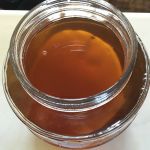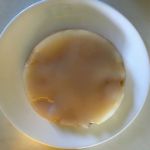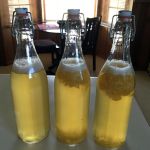 Today, it was time to cycle out a batch of kombucha tea. Every two weeks, a new batch is ready for bottling. This batch was from 12/20, composed of the following tea(bags): 2 darjeeling, 2 green, 1 white, and 1 oolong.
Today, it was time to cycle out a batch of kombucha tea. Every two weeks, a new batch is ready for bottling. This batch was from 12/20, composed of the following tea(bags): 2 darjeeling, 2 green, 1 white, and 1 oolong.
 Per the standard procedure, new sweet tea was made, inoculated with some of the previous batch, the jar was filled with reverse osmosis filtered water, and the SCOBY was added to the fresh mix. It will sit, covered with a breathable cover, for two weeks. If it ferments for longer than that, it will become much more vinegary…in fact, there are designated jars with batches that have been left for a month or longer, specifically to turn into kombucha vinegar.
Per the standard procedure, new sweet tea was made, inoculated with some of the previous batch, the jar was filled with reverse osmosis filtered water, and the SCOBY was added to the fresh mix. It will sit, covered with a breathable cover, for two weeks. If it ferments for longer than that, it will become much more vinegary…in fact, there are designated jars with batches that have been left for a month or longer, specifically to turn into kombucha vinegar.
 The kombucha ready for bottling (batch 51) is strained through a plastic sieve into flip-top bottles. These are thick, Italian-made glass bottles – there’s a reason for using this type of bottle. Once bottled, the kombucha will sit for another few days in a “second ferment”. It’s at this stage that flavors can be added, usually through adding fruit or fruit juice. Pineapple complements the tart kombucha flavor profile well, so crushed fresh pineapple was added to two of the bottles (the other remained “plain”). These bottles will sit on a shelf for another three days, then the fruit will be strained out and the bottles will go into the refrigerator.
The kombucha ready for bottling (batch 51) is strained through a plastic sieve into flip-top bottles. These are thick, Italian-made glass bottles – there’s a reason for using this type of bottle. Once bottled, the kombucha will sit for another few days in a “second ferment”. It’s at this stage that flavors can be added, usually through adding fruit or fruit juice. Pineapple complements the tart kombucha flavor profile well, so crushed fresh pineapple was added to two of the bottles (the other remained “plain”). These bottles will sit on a shelf for another three days, then the fruit will be strained out and the bottles will go into the refrigerator.
Back to the glass bottles: though this should be obvious, care needs to be exercised when fermenting, including when making kombucha. While it’s usually desirable to have some pressure build up and create carbonation, there’s a fine line between nicely carbonated and overcarbonated, the latter of which can result in unpleasant things like exploding bottles showering glass shards everywhere. For this reason, I don’t add extra sugar during the second ferment. To me, carbonation is a plus, not a necessity. The sugar in fresh fruit is generally sufficient to create some fizz. Some kombucha brewers even second ferment their bottles in cardboard boxes to ensure that any such explosions are contained.
When using fruit with a high sugar content, I “burp” the flip-top bottles twice a day and if one or more is too enthusiastic, will pull it and put it in the fridge to continue its second ferment. Sometimes, kombucha with a pineapple second ferment can verge on overcarbonated. Be warned, however, that while putting the bottle in the fridge will slow the fermentation process, it still may not prevent too much pressure from building in the bottle; recently, a bottle of “pina colada” (pineapple/banana/coconut) water kefir blew in the fridge and created the mother of all messes. I’m going to lay off making that one until I figure out the safe levels of fruit to add.
Favorite kombucha second-ferment flavors: pineapple, fig (dried), ginger – I’ve tried others, but the strong flavor of the base kombucha tea seems to overpower many, like apple. I’m always looking for new flavors, so let me know if you’ve discovered some good ones.
You might be wondering what happens to all those extra SCOBYs that are created (one grows in each batch of kombucha tea) – the chickens get them. The chickens and ducks also enjoy a splash of kombucha tea vinegar in their water, and I think the probiotics help keep them healthy.
Resources
Want to learn more about kombucha tea? Cultures for Health has information and tutorials. If you’re new to making it, Homebrewtalk.com’s Kombucha & Fermented Tea Forum allows you to ask other brewers questions.

Comments are closed.